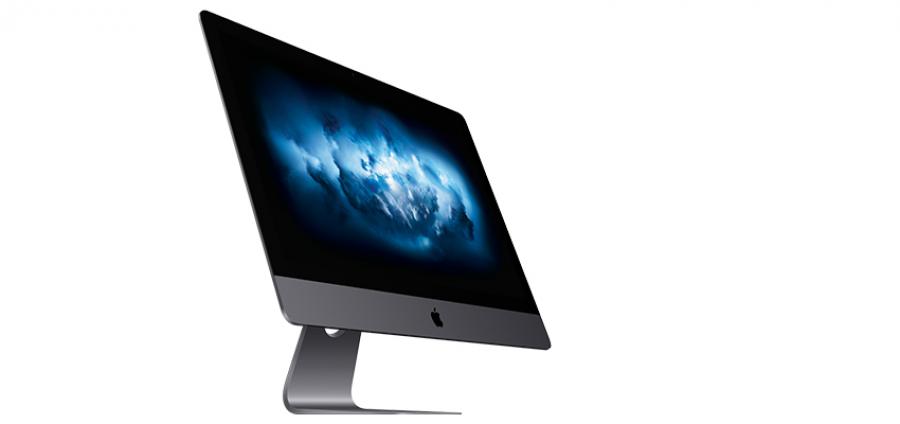
iMac Pro First Impressions
With a sleek Space Grey look, the new iMac Pro certainly looks the part. Before you rush out to buy one, read our buyer’s guide to make sense of the new options.
Specification
There is one base model of iMac which can be upgraded to the specification you need. The table below describes what configuration options there are:
Specification | Standard Options | Configurable Options |
Processor | 8-Core 3.2GHz Intel Xeon W; Turbo Boost up to 4.2GHz 19MB cache |
|
Graphics | Radeon Pro Vega 56 graphics processor; 8GB of HBM2 memory; 56 compute units; 3,584 stream processors; 9 teraflops single precision; 18 teraflops half precision |
|
Memory | 32GB of 2666MHz DDR4 ECC memory; Quad-channel memory controller |
|
Storage | 1TB SSD |
|
The other specifications that are included with all models are:
- 1080p FaceTime HD camera
- Simultaneously supports full native resolution on the built-in display at 1 billion colours and:
- Two 5120x2880 (5K) external displays at 60Hz with support for 1 billion colours, or
- Four 3840x2160 (4K UHD) external displays at 60Hz with support for 1 billion colours, or
- Four 4096x2304 (4K) external displays at 60Hz with support for millions of colours
- Support for extended desktop and video mirroring modes
- Thunderbolt 3 digital video output
- Native DisplayPort output over USB‑C
- Thunderbolt 2, HDMI, DVI and VGA output supported using adapters (sold separately)
- Stereo speakers
- Four microphones
In terms of connectivity, on the rear of the new iMac Pro, running left to right, there are -
- 1x 3.5mm headphone jack
- 1x SDXC Card Slot
- 4x USB 3 (USB-A)
- 4x Thunderbolt 3 (USB-C)
- 1x 10Gb Ethernet
Notable, is the inclusion of USB-A, and an SD card slot, providing Pro users with legacy connectivity unavailable on the latest MacBook Pro's. It also comes in a snazzy ‘Space Grey’, which clearly sets it apart from standard iMacs.
The new iMac Pro also includes Apple’s custom T2 processor, designed to improve integration and security. The T2 encrypts your SSD using dedicated AES hardware, meaning the SSD’s performance is unaffected, as well as leaving the main processor unhindered as well.
Post-Purchase Upgrading
So, you’ve purchased your iMac Pro, and used it for a few weeks but, you realise the base 32GB isn’t enough… Can more be added later? Possibly, however it will be an engineer-fit only option. The process to getting to the RAM slots is similar to the 2012 21.5” iMac. The screen must be removed, which is held on with adhesive tape which will need to be replaced when reassembling. The logic board will also need removing, as the RAM slots are on the other side. In order to remove the logic board, the fans must be removed, as well as the speakers.
On that basis, we would recommend purchasing your iMac Pro with a bespoke specification, including the RAM and hard drive upgrades you will need for the lifetime of the product. Also, bear in mind that whatever applications you use now will probable need more and more memory as they are updated in the future.
With this is mind, a solid performance specification would include the following:
- 10-Core 3.0GHz
- 128GB RAM
- Radeon Pro Vega 64
- 1TB SSD
The 10-Core 3.0GHz appears to hit the sweet spot of number of cores vs single core speed; the RAM and GPU are the main reason you’d be buying this level of machine, so maxing both of those would be prudent; the internal SSD could be kept to the base 1TB, as external storage is easy to add later, allowing you in to offload files you are not working on at that moment.
Reviews
Now that the iMac Pro has begun to be available to customers, the reviews are out and the majority of them agree; this is a fantastic machine.
Some of the highlights include:
It's that combination of power and experience that feels especially compelling. The ability to run three iOS simulators at once, alongside multiple virtual machines covering a range of operating system and web and browser environments (with so many tabs!), and still having headroom to spare — essentially being all-in-one on your all-in-one — will no doubt be terrific for app and web devs alike.
Most pros I know want something that's quick and easy to setup up, a machine that performs well and is reliable, and is backed up by a solid company and warranty should issues arise. That has typically been an iMac, but for those who have wanted a bit more power (or a lot more), enter the iMac Pro.
Should I Buy One?
No one can answer this question but you, however, we'd love to help out with some advice. If you like the look of the sleek all-in-one, and you need more power than the iMac 5K can provide, this is for you.
This is a powerful machine, full of indicators of the direction of Apples Pro-level products. Secure processing and encryption of data, a unique internal design focussed on high-performance, with whisper-quiet fans, it's clearly focussed on professional users needs.
Hopefully this guide has been useful to you. If you have any further questions, please get in contact at info@krcs.co.uk, or call 0115 985 1797 to speak to our business team.
Follow us on Twitter.
Email us at info@krcs.co.uk
Call us on 0115 9851797
No Comments yet. be the first to comment.